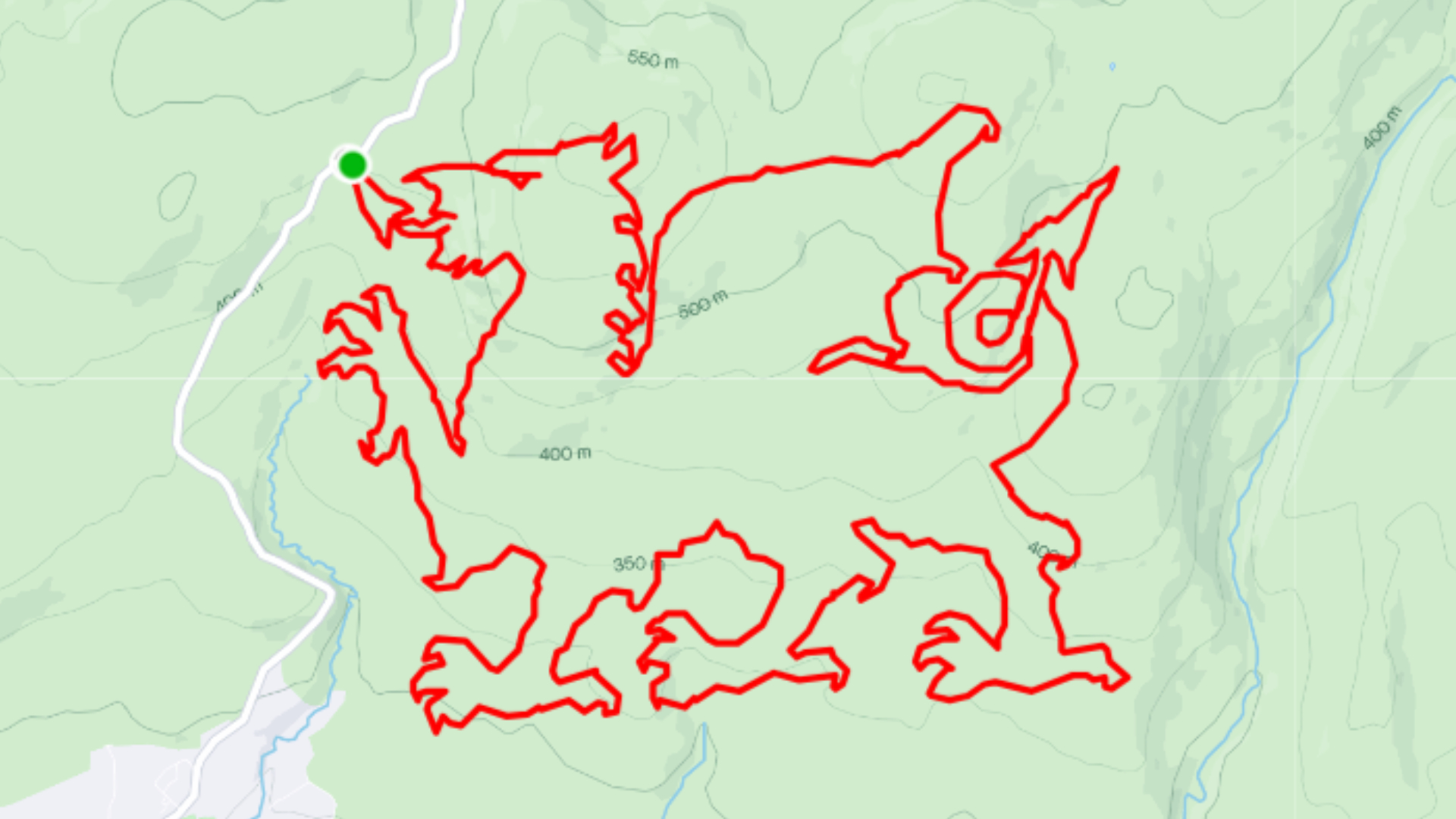
When Terry Rosoman from Wales, UK, wanted a novel idea to raise awareness about men’s mental health issues for Movember, it didn’t take him long to come up with the idea of creating a piece of Strava art – more specifically, a giant GPS penis.
While the charity’s logo is a mustache, Rosomon reckoned the male phallus was the symbol that would really get peoples’ attention. He didn’t want to offend anyone, he just claimed that most of his “target demographic” would find the shape “hilarious”.
On Friday November 1 he set off at 5pm to run a course in Wales’ Bannau Brycheiniog National Park, covering 75 miles and 2,800m of ascent, creating an outline of a male genitalia at the same time. He didn’t sleep, and crossed the finish line at 4.30pm on Saturday. He's managed to raise more than £9,000 ($11,630) for his efforts.
It’s an impressive feat, but Strava artists have been raising money and breaking records with their active artworks for a while now, and most of them with designs that are a little more easy on the eye. Cleverly planning their routes with pen and paper or digital route planners, they then set about tracing them using muscle power – hiking, biking, paddling or swimming – to craft the iconic red line shapes.
Check out some of these amazing masterpieces we've found on Strava ,then scroll on down to find top tips on how to create your first piece of Strava art.
1. Dragon

Staying in Wales, we found this incredible Welsh dragon by Martyn Driscoll, who ran almost 28 miles and conquered 2,055m of elevation to create the mystical symbol from the country's national flag. He's created the run as a Strava segment, letting followers know in the comments that they can export the gpx file if they want to have a crack at it. "I'd be really impressed if our time was beaten," he says, and suggests waiting for a series of long sunny days to dry up the ground first.
2. Tiger

One of the best-loved creators of Strava art is Lenny Maughan, admired for the extraordinarily detailed depictions that he creates around his home city of San Francisco. He's traced everything from Wile E. Coyote to Big Foot.
He takes inspiration from everyday things, such as tattoos, adverts and signs, then sketches his design onto a map. This tiger took a whopping 95 miles on foot to create.
He's a champion of the 'pause and resume' method, pointing out in a Strava story that if you come across an obstacle that will disrupt your path, you can pause the recording, go around the obstacle, then reconnect, so that Strava draws a straight line between the two points. "You can Pause/Resume anytime along the way; for a quick bathroom break or even overnight if you want to continue from that point the next day," he explains.
3. Camel

Gustavo Lyra was glad of a bit of rain while creating this monster-sized camel on the dunes of Extremoz in Brazil, which hardened the ground a little for their seven-mile walk. He was able to get amazing definition in the head and legs hon the canvas of sand. Creating elaborate designs, which have included maps of the US and intricate hummingbirds, he truly is the Strava art king of South America.
4. Heron

Strava users are taking to the water to create amazing artworks too, which are less hindered by manmade and natural obstacles. Check out Jonathan O'Keeffe's mighty heron, which he created at Pine Island Lake, Westhampton, Massachusetts in just 1 hour 7 mins moving time in a kayak.
He reveals to his followers how he's done it in his post, starting with finding the right graphic and simplifying it as much as possible. "Convert that to vector format (SVG)," he explains, "then the SVG into a single path in pixel coordinate space, then converting that to lat/long with appropriate pan and scale. Convert that to a GPX file, load into RideWithGPS, cross fingers, and start paddling!"
5. Olympic rings

In 2024 two cyclists set out to break the record for the world's biggest piece of Strava art by creating the Olympic rings in the run-up to the Paris 2024 Olympics.
Guillaume Koudlansky de Lustrac and Vincent Brémond rode 1,354 miles over 10 days. The ultra-endurance athletes hoped they'd inspire others to explore new avenues of expression through physical activity, "even if it’s to draw just a five-kilometer letter or something".
Create your own Strava art

Start following creators who make Strava art and you'll pick up hints and tips from them. The main piece of advice they're all keen to share is to start simple. Even if it's an ultra-simple shape or letter, you'll soon master the basics and who knows, maybe one day you'll be the next Cézanne of Strava.
1. Find your design
Try a simple symbol with straight lines and not too many joined-up elements.
2. Plan your route
Use Strava route planner or other route planning software, or go old-school with pen and a map.
3. Practice in an empty field or open space
Free from obstacles, you'll be able to master the basics quickly. Try walking or jogging your first one, so you don't have to worry about coordinating equipment at the same time.
4. Don’t worry about the intricacies
When it comes to creating large Strava artworks, having to retrace your path, or veering slightly off your course, won't matter. Zoomed out, a wobbly line won't show up clearly, and is all part of the charm.
5. Use the 'pause and resume' method
If you get obstructed by a tree, watercourse or building, or simply want to create an ultra straight line, pause your recording, continue to your next point, then resume, creating a neat line.
- For the latest creations, check out the Strava Art club.







